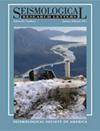Induced or Natural? Toward Rapid Expert Assessment, with Application to the Mw 5.2 Peace River Earthquake Sequence
IF 3.2
3区 地球科学
Q2 GEOCHEMISTRY & GEOPHYSICS
引用次数: 0
Abstract
Based on information available at the time, several questionnaire-based schemes have been developed to provide a qualitative assessment of whether a specific earthquake (or earthquake sequence) was likely induced by anthropogenic activities or is inferred to be natural. From a pragmatic perspective, the value of this assessment is arguably the greatest in the immediate aftermath of an event (hours to days), because it could then better serve to guide regulatory response. However, necessary information is often incomplete or uncertain, and there remains a lack of scientific consensus on the most distinctive attributes of induced (vs. natural) earthquake sequences. We present a case study of the Mw 5.2 Peace River earthquake sequence (Alberta, Canada), evaluated using two published frameworks for origin interpretation. The Alberta Energy Regulator initially considered the sequence to be natural, but a study published ~4 mo later came to the opposite interpretation. Prior to this publication, we convened a panel of experts who completed questionnaires as set out by the frameworks; results using both schemes indicate that experts believe the sequence was likely induced. Based on these expert responses, we critically evaluate information that was available publicly in the weeks to months following the mainshock on 30 November 2022; reassess the relative importance of various components of the questionnaires from a parsimonious, rapid-response perspective; and consider other types of information that could be critical for near-real-time assessment of whether an event was induced or natural.诱发还是自然?实现快速专家评估,并应用于 5.2 级和平河地震序列
根据当时可获得的信息,已经制定了若干基于调查问卷的方案,对特定地震(或地震序列)是可能由人为活动诱发还是推断为自然地震进行定性评估。从实用的角度来看,这种评估在事件发生后的第一时间(数小时至数天)价值最大,因为这样可以更好地指导监管对策。然而,必要的信息往往是不完整或不确定的,而且对于诱发地震(与自然地震)序列的最显著特征仍然缺乏科学共识。我们对加拿大阿尔伯塔省 5.2 兆瓦和平河地震序列进行了案例研究,并使用两个已发布的震源解释框架进行了评估。阿尔伯塔省能源监管机构最初认为该地震序列是天然的,但 4 个月后发表的一项研究得出了相反的解释。在发表该研究报告之前,我们召集了一个专家小组,他们按照上述框架的要求填写了调查问卷;使用这两种方法得出的结果表明,专家们认为该序列很可能是诱发的。根据这些专家的回答,我们对 2022 年 11 月 30 日主震发生后几周到几个月内可公开获得的信息进行了严格评估;从解析、快速反应的角度重新评估了调查问卷各组成部分的相对重要性;并考虑了对近实时评估事件是诱发的还是自然的至关重要的其他类型的信息。
本文章由计算机程序翻译,如有差异,请以英文原文为准。
求助全文
约1分钟内获得全文
求助全文
来源期刊

Seismological Research Letters
地学-地球化学与地球物理
CiteScore
6.60
自引率
12.10%
发文量
239
审稿时长
3 months
期刊介绍:
Information not localized
 求助内容:
求助内容: 应助结果提醒方式:
应助结果提醒方式:


